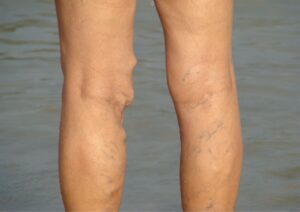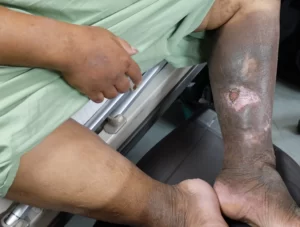Your face is a canvas that tells the story of your life, but sometimes, it reveals more than you’d like it to. If you’ve noticed tiny, web-like red or purple veins or broken capillaries gracefully making their presence known on your cheeks or nose, fret not – you’re not alone.
These delicate veins, known as spider veins/ broekn capillaries on the face, affect millions of people worldwide.
In this blog, we will explore the world of facial spider veins, exploring their causes, available treatments, and essential prevention tips to help you maintain a clear and radiant complexion.
What Are Spider Veins/Telangiectasia?

A spider vein, also known as telangiectasia or broken capillary, is a small, dilated widened blood vessels that appear close to the skin’s surface.
While they are commonly associated with the legs alongside with varicose veins, a spider vein can also manifest on the face, creating a delicate, spider-web-like pattern.
These veins are typically red or purple in colour and can vary in size and shape.
What Causes a Telangiectasia/Spider Vein on the Nose and the Face?
Several factors contribute to the development of a facial spider vein:
Heredity:
Genetics can play a significant role in the likelihood of developing facial spider veins. If your parents or close relatives have experienced this condition, you may be more prone to present abnormal blood vessels.
Sun Exposure:
Prolonged exposure to harmful UV rays can weaken the skin’s tiny blood vessels, making them more susceptible to becoming dilated blood vessels.
Age:
As we age, our skin loses elasticity, and the blood vessels in the skin become more prominent, leading to the appearance of spider veins.
Hormonal Changes:
Fluctuations in hormone levels, such as during pregnancy or menopause, can influence the development of facial spider veins.
Rosacea:
Individuals with rosacea, a common skin condition characterised by facial redness and increased skin sensitivity, may be more susceptible to spider veins.
What Diseases Are Associated With Telangiectasia?
Telangiectasia can be associated with several different medical conditions including connective tissue disease and immune system disease. Some of the most common diseases and syndromes that may involve telangiectasia as a characteristic feature include:
1. Hereditary Hemorrhagic Telangiectasia (HHT):
Also known as Osler-Weber-Rendu syndrome, HHT is a genetic disorder that affects blood vessels. It is characterised by the development of multiple telangiectasias in the skin and mucous membranes, particularly in the nose, mouth, lungs, and gastrointestinal tract. Individuals with HHT may experience recurrent nosebleeds, and in severe cases, there can be complications such as arteriovenous malformations (AVMs) in internal organs.

2. Ataxia Telangiectasia (A-T):
A-T is a rare inherited disorder that affects the nervous system and causes progressive difficulty with coordination (ataxia), as well as immune system problems. Telangiectasias on the conjunctiva and skin are one of the defining features of this medical condition.
3. Bloom Syndrome:
Bloom syndrome is a rare genetic disorder that increases the risk of developing various health issues, including telangiectasias, sun sensitivity, and an increased risk of cancer.
4. Spider Telangiectasia:
Spider telangiectasias are characterised by a central red spot with smaller capillaries radiating outward like the legs of a spider. While not a disease itself, spider telangiectasias can be seen in various conditions, including liver disease (such as cirrhosis), hormonal changes (e.g., during pregnancy), and as a side effect of certain medications.
5. Rosacea:
Rosacea is a chronic skin disease causing patches that present with facial redness, flushing, and sometimes acne-like bumps. In some cases, rosacea can lead to the development of telangiectasias on the face, especially on the cheeks and nose.
6. Crest Syndrome (Limited Systemic Sclerosis):
A subtype of systemic sclerosis (scleroderma), Crest syndrome can be associated with telangiectasias, along with calcinosis (calcium deposits), Raynaud’s phenomenon, esophageal dysmotility, and sclerodactyly (thickening and tightening of the skin on the fingers and hands).
7. Poikiloderma of Civatte:
This condition is characterised by redness, thinning of the skin, and pigment changes on the sides of the neck and the chest. It is often associated with chronic sun exposure and can feature telangiectasias.
How is Telangiectasia Connected to Scleroderma, Dermatomyositis and Lupus?
Telangiectasia can be a rare disorder associated with several autoimmune and connective tissue diseases, including scleroderma, dermatomyositis, and lupus. Here’s how telangiectasia is connected to each of these conditions:
1. Scleroderma (Systemic Sclerosis):
Scleroderma is a chronic autoimmune disease that affects the connective tissues, leading to excessive collagen production and fibrosis in various organs and tissues. There are two main subtypes of scleroderma: limited cutaneous systemic sclerosis (lcSSc) and diffuse cutaneous systemic sclerosis (dcSSc). The presence of telangiectasia is more common in the limited cutaneous form of the disease, often referred to as CREST syndrome, which stands for:
– C: Calcinosis (calcium deposits in the skin)
– R: Raynaud’s phenomenon (color changes in the fingers or toes due to cold or stress)
– E: Esophageal dysmotility (difficulty swallowing)
– S: Sclerodactyly (thickening and tightening of the skin on the fingers and hands)
– T: Telangiectasia
The “T” in CREST syndrome represents the presence of telangiectasia, which can be seen as small red spots on the skin, particularly on the face, hands, and mucous membranes. The exact cause of telangiectasias commonly occur in scleroderma is not fully understood, but they are believed to result from the dilation of small blood vessels due to the underlying vascular abnormalities in the disease.
2. Dermatomyositis:
Dermatomyositis is an inflammatory myopathy characterized by muscle weakness and skin changes. The skin changes in dermatomyositis can include a distinctive rash called “Gottron’s papules” and “heliotrope rash” around the eyes. In some cases, telangiectasia can also be present in the skin affected by dermatomyositis. The mechanism behind the development of telangiectasia in dermatomyositis is not entirely clear, but it may be related to vascular damage and inflammation in the skin.
3. Lupus (Systemic Lupus Erythematosus):
Lupus is a systemic autoimmune disease that can affect multiple organs and tissues. While telangiectasia is not a characteristic feature of lupus, it can be seen in some individuals with the disease. Telangiectasia in lupus may result from the underlying vascular inflammation and damage seen in the condition. It is important to note that not all individuals with lupus will have telangiectasia, and its presence may vary depending on the individual and the severity of their disease.
Treatment Options for Facial Spider Veins
How do I get rid of spider veins on my face?

Fortunately, there are several effective treatment options available for managing facial spider veins:
Laser Therapy:
Laser treatments are one of the most popular methods for addressing spider veins on the face. The laser emits an intense light that is absorbed by the blood vessel or vessels, causing them to collapse and fade over time. This non-invasive procedure is generally well-tolerated and has minimal downtime.
Sclerotherapy:
Sclerotherapy is a treatment in which a solution is injected directly into the spider veins, causing them to collapse and be reabsorbed by the body. This technique is more commonly used for larger spider veins and is highly effective in diminishing their appearance.
Intense Pulsed Light (IPL) Therapy:
IPL, laser therapy that uses multiple wavelengths of light to target and break down spider veins on the face. It is particularly beneficial for individuals with fair skin and light-colored veins.
Radiofrequency Ablation:
Radiofrequency ablation is a technique laser treatment that utilizes radiofrequency energy to heat and destroy the affected blood vessels, leading to their gradual disappearance.
Preventing Facial Spider Veins
While not all cases of facial spider veins can be prevented, there are steps you can take to reduce the likelihood of their development:
Sun Protection:
One of the most crucial preventive measures is protecting your skin from the sun’s harmful UV rays. Always wear sunscreen with at least SPF 30 when going outside, and use protective clothing and hats to shield your face.
Skincare Routine:
Incorporate products that promote skin health and contain antioxidants to protect blood vessels from damage. Moisturizers with ingredients like vitamin C and vitamin E can be particularly beneficial.
Manage Rosacea:
If you have rosacea, work with a dermatologist to manage the condition effectively and reduce its impact on your skin.
Avoid Harsh Facial Treatments:
Treat your skin gently and avoid aggressive facial treatments that could exacerbate spider veins.
Conclusion:

Facial spider veins may be an unwelcome addition to your face, but with the range of effective treatments available and preventive measures, you can achieve a clearer and more confident complexion. Remember, always consult with a qualified dermatologist to determine the best course of action for your unique needs. Your skin deserves the utmost care, and with a little knowledge and the right approach, you can maintain its beauty and radiance.
Here’s to healthy, beautiful skin!










